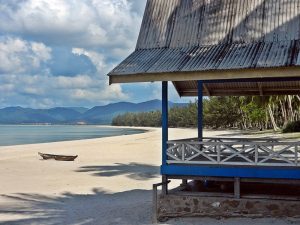Cruising the Anambas: Know before you go
We have now spent the past two summers, 2016 and 2017, cruising the Anambas and had a marvellous time snorkelling and diving in the clear water and meeting the wonderful and sometimes shy people.
Published 6 years ago


The elimination of the costly CAIT and the opening of Tarempa as an international clearance port make visiting these islands simpler and less costly. In the past, the Anambas had gotten a poor reputation due to some piracy incidents but nothing has been noted in the past few years. In fact, when we asked a local person in the piracy vicinity about problems with piracy, he replied: “The pirate died”. When we further asked whether the pirate had a son, the man just laughed. So based on our and others’ recent visits, I would say it is not a problem but I would always recommend caution whenever travelling in countries where you are perceived as “rich”. Expect that you may be approached by fishermen and young people. They are just curious about your boat. But generally, we, more often than not, had to approach fishing boats to buy fish.
I won’t go into detail about the many anchorages that we visited as Neville and Glenys aboard SV ALBA have written a very detailed cruising guide regarding their visit on their website:
http://thehowarths.net/cruising-information/cruising-notes/449-the-anambas-islands-2016
But I will offer some additional comments and reinforce some issues:
- You can internationally check into/out of the Anambas, Indonesia at the main port of Tarempa on Pulau Siantan. You must visit Immigration, Customs, Quarantine, and the Port Captain/Harbormaster in that order. Bring along your boat stamp. Clearing in was free. A special one-stop CIQP office on the waterfront was set up especially for the SailMalaysia Rally visit, but normally you have to visit each individual office. Clearing out you visit the offices in the same order and the only fee paid was for harbour dues of which we paid less than $3 USD on 14 net tons. I couldn’t figure out their formula on the receipts.
- We stopped on our way from Malasia at Pulau Bawah in June 2017, but resort security would not allow us ashore if you haven’t cleared and they must have telephoned and checked. They would allow us to take a mooring and go swimming or diving, just not go ashore. (Note: It was reported on Noonsite by Liz on K’GARI that Bawah Resort is now charging $5 USD/ft./night for the moorings and that allows you access to the resort facilities and free-flow soft drinks.)
- To apply for a Tourist visa to Indonesia, go to the consulates in Penang or Johor Bahru or the Embassies in KL or Singapore. Each office uses its own application. Regarding dress code in Penang, my husband wore long shorts but was given a sarong by the guard to wear. My ¾ pants and our rubber thongs were not rejected. (Update Oct. 2017: It appears that the Indonesian Embassy in KL is only giving out 30-day Social Visas. I called the Indonesian Consulate in Penang and they said they do give out 60-day Social Visas; just include your boat registration/documentation.)
- We extended our visas twice in 2016 at Tarempa, Anambas for additional 30 days. The cost was total of 355,000 Rp per person (approx. $27 USD) each time. No letter of request was needed the second time and the process was completed in one day. In 2017, we did not extend our visas, but we know of several boats that did with no problems. I believe the fee was the same.
- When arriving Tarempa (domestic clear-in), it is advisable to check in with Customs, Immigration, Harbor Master, and Quarantine, as they just want to know that you are in their waters. The Harbor Master was the most difficult to find at his office; the best time we found was when a ferry was in.
- We can’t recommend enough the use of OpenCPN utilizing Google Earth-generated charts for navigation. ALBA’s website has a KAP file (470 MB) to download that encompasses almost all the satellite photos you would need for cruising the Anambas. These satellite “charts” made a tremendous difference in navigating, as most times Navionics, Camp or OpenCPN with CM93 charts would have you on land or anchoring on a reef.
- Maps and charts of the Anambas can differ wildly on the spelling of island names.
- Expect most anchorages to be 50-70 ft. (15-21 m.) deep on silty sand although catamarans may be able to cross reef and find shallower spots. Most anchorages are edged with the reef at the beachhead with depths that drop off quickly such that around 60+ ft. (18+ m.) generally finds you in clear sand. Some anchorages have scattered coral heads around.
- One major exception is the Pantai Malang anchorage at Telok Mampo, on the north side of Pulau Jemaja. This very large, almost all-sand bay shoals slowly from 45 ft (15 m.) right up to the beach so that hundreds of boats could anchor almost anywhere, in any depth. Letong, the 2nd largest town, is a 2-mile walk.
- Dinghy landing at Tarempa is challenging. The floating dock that was present in 2016 in front of the RSUD (blue and white) building on the waterfront was no longer in operation in 2017. The floating docks were tied off to pilings on the wall and the gangway was removed. Maybe the Navy will resurrect it in 2018. Other choices available but limited in landing space are:
- Fixed dock off the causeway. Do not tie off to the face as it is used by pong-pongs to load and unload. Rather, tie bow & stern off either end and to the causeway. You cannot drop a stern anchor as coral surrounds the dock.
- Within the taxi-boat basin. There are 2 wood lattices affixed to the walls. Best if you tie off in the corner and climb the lattice and walk the wall. You can also drop or pick up someone at the concrete steps. Note this area has much day traffic.
- At the concrete steps on the end of the ferry dock, just east of the commercial dock. Stay close to the steps, out of the way of ferries. Pong-pongs also drop off/pick up here but not frequently.
- Concrete steps at the back of the fish market. This cuts the walk short if just going to the fish market. Fishing boats usually take up space off the front of the steps but you can tie in the gap behind.
- Note that there are 3 fingers of reef that come out perpendicular to the causeway in Tarempa; in front of the small police station, in front of the karaoke bar, and further north marked by a stick. If you use a fish finder for a depth sounder, you can see the rough surface of the bottom. Look for a smooth surface for the sandy area. Up closer to the blue & white RSUD building, the bottom is shallower and all sand but there may be much trash i.e. rice bags, plastic shopping bags, and one time we picked up an entire blanket. Make sure your anchor holds.
- Provisioning in Tarempa is pretty good although you may have to wait for the next produce ship to arrive. But they do come fairly frequently. You can even find broccoli, cauliflower, rock melon, and green pears. If you are a pasta lover, I suggest you make sure to bring all you may need. I only found one brand of macaroni and would not recommend it. There is no yoghurt and breakfast cereals consist of oatmeal, corn flakes, or coco-crunch. I’m unsure regarding unsweetened UHT milk as I had brought my own. Beer is available at the Chinese-run stores. Canned foods are limited. You just need to wander the town and investigate. Meats are usually kept frozen but the fish market is fairly good. The village of Letong on P. Jemaja has much less in terms of shopping and fresh produce is a bit scattered around. You can usually find basics in the larger villages but don’t plan on major provisioning outside Tarempa or Letong.
- The channel between P. Sintan and P. Bajau is passable. What appears to be a shoal area at 03°08.169 N/106°17.243 E had no less than 25 ft. (8 m.) at its shallowest point.
- Most villages have phone signals. Only Tarempa had any semblance of internet albeit very slow and a good test of patience; best in the middle of the night when no one is on. Café Luna and the Sakura Hotel on the waterfront in Tarempa have usable WiFi. You need to walk towards or go into Letung, P. Jemaja, to catch the internet. At many anchorages you may get an inconsistent signal (E), again better at night, to download a grab file or send a quick message.
- The snorkelling is good but we expected to see more and larger fish in this area. Don’t overlook the rocky areas to snorkel.
- On our passage from Anambas to Pulau Tioman, Malaysia we noticed some commercial ships in the South China Sea shipping lanes not broadcasting on AIS at nighttime. After shining a light on our sails, one ship did turn his AIS on. So be warned!
Nancy Paterson
SV AMULET
November 5, 2017
The opinions expressed in this article are the author’s own and do not reflect the view of noonsite.com or the World Cruising Club.
Related content
Tarempa, Siantan (Anambas Islands)
Indonesia: The Amazing Anambas
Related to following destinations: Indonesia, Tarempa - Siantan (Anambas Islands), Western Indonesia - Bintan/Lingga/Riau and Anambas Islands


